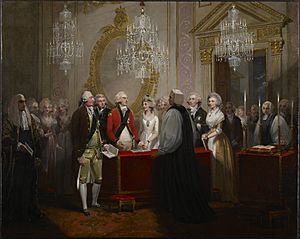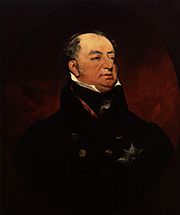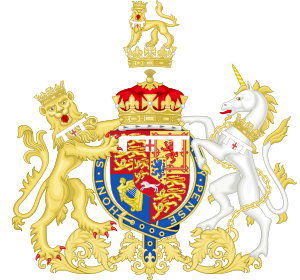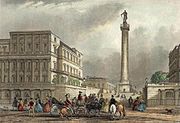Prince Frederick, Duke of York and Albany facts for kids
Quick facts for kids Prince Frederick |
|||||
|---|---|---|---|---|---|
| Duke of York and Albany | |||||
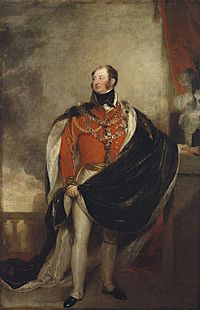
The Duke of York, painted by Sir Thomas Lawrence, in the uniform of a field marshal, with the mantle of the Order of the Garter, holding his marshal's baton in his left hand
|
|||||
| Born | 16 August 1763 St. James's Palace, London |
||||
| Died | 5 January 1827 (aged 63) Rutland House, London |
||||
| Burial | 20 January 1827 Royal Vault, St George's Chapel, Windsor Castle |
||||
| Spouse | |||||
|
|||||
| House | Hanover | ||||
| Father | George III, King of the United Kingdom | ||||
| Mother | Charlotte of Mecklenburg-Strelitz | ||||
| Military career | |||||
| Allegiance | |||||
| Service/ |
|||||
| Years of active service |
|
||||
| Rank | Field marshal | ||||
| Unit | Life Guards | ||||
| Commands held | Commander-in-Chief of the Forces | ||||
| Battles/wars | |||||
Prince Frederick, Duke of York and Albany (born Frederick Augustus; 16 August 1763 – 5 January 1827) was an important member of the British Royal Family. He was the second son of King George III and Queen Charlotte.
Frederick was a soldier for most of his life. From 1764 to 1803, he was the Prince-Bishop of Osnabrück in the Holy Roman Empire. After his father died in 1820, Frederick became the next in line to the throne after his older brother, King George IV.
He joined the British Army at a young age. By the age of thirty, he was given a high command role. He led a difficult campaign during the War of the First Coalition. Later, as Commander-in-Chief during the Napoleonic Wars, he made huge changes to the British Army. He is remembered for improving the army more than anyone else in its history.
Contents
Early Life and Royal Connections
Prince Frederick Augustus was born on 16 August 1763, at St James's Palace in London. His father was King George III, the ruler of Britain. His mother was Queen Charlotte.
When Frederick was only six months old, he became the Prince-Bishop of Osnabrück. This was a special role that came with a good income. He kept this position until 1803. He also received important royal honours, becoming a Knight of the Order of the Bath in 1767 and a Knight of the Order of the Garter in 1771.
Military Career
King George III wanted his second son, Frederick, to have a career in the army. Frederick became a colonel in 1780. From 1781 to 1787, he lived in Hanover, where he studied at the University of Göttingen. He was promoted several times, becoming a major-general in 1782 and a lieutenant general in 1784.
In 1784, he was given the titles Duke of York and Albany and Earl of Ulster. He also became a member of the Privy Council.
Leading Troops in Flanders
On 12 April 1793, Frederick became a full general. He was sent to Flanders to lead the British part of an army invading France. Frederick and his troops faced very tough conditions. They won some battles, like the Siege of Valenciennes in July 1793. However, they were defeated at the Battle of Hondschoote later that year.
In 1794, he had successes at the Battle of Beaumont and the Battle of Willems. But he was defeated at the Battle of Tourcoing. The British army left Flanders in April 1795.
Commander-in-Chief of the Army
After returning to Britain, Frederick was promoted to field marshal in 1795. On 3 April 1795, his father, King George III, made him the Commander-in-Chief of the British Army.
Frederick knew the army had many problems from his time in Flanders. He promised to fix these issues. His second command was during the Anglo-Russian invasion of Holland in 1799. This campaign was difficult due to a lack of supplies and other problems. Frederick signed an agreement for the allied forces to withdraw.
His experiences in these campaigns showed him how much the British army needed to improve. As Commander-in-Chief, Frederick started a huge program of reforms. He is largely responsible for making the British army much stronger. Many historians believe he did "more for the army than any one man has done for it in the whole of its history."
Frederick also strongly supported the creation of the Royal Military College, Sandhurst in 1801. This college helped train future army officers professionally.
In 1809, Frederick resigned as Commander-in-Chief due to a public controversy. Someone associated with him was accused of misusing his name to sell army positions. Parliament investigated the matter and eventually found Frederick innocent of taking bribes. Two years later, he was reappointed Commander-in-Chief in 1811.
Frederick enjoyed London's social life, including card games and horse racing. This sometimes led to him being in debt. After his niece, Princess Charlotte, died in 1817, Frederick became second in line to the throne. In 1820, he became the direct heir to his brother, King George IV.
Death
Frederick died in London in 1827 from a condition called dropsy and heart problems. His funeral was held at St George's Chapel, Windsor Castle, where he was buried.
Family
Frederick married his cousin, Princess Frederica Charlotte of Prussia, in 1791. She was the daughter of King Frederick William II of Prussia. They had two wedding ceremonies, one in Berlin and one at Buckingham Palace. Their marriage was not a happy one, and they soon lived separately. Frederica lived at Oatlands until her death in 1820.
Titles, Honours, and Coat of Arms
Titles and Styles
- 16 August 1763 – 27 November 1784: His Royal Highness The Prince Frederick
- 27 November 1784 – 5 January 1827: His Royal Highness The Duke of York and Albany
Honours
Frederick received many honours during his life:
- Royal Knight of the Order of the Garter, 19 June 1771
- Knight Grand Cross (military) of the Order of the Bath, 2 January 1815
- Knight Grand Cross of the Royal Guelphic Order, 12 August 1815
- Knight of the Order of the Black Eagle of Prussia, 11 April 1814
- Knight of the Order of the St-Esprit of France, 21 April 1814
- Knight of the Order of St. Andrew of Russia, 9 June 1814
- Knight of the Order of St. Alexander Nevsky of Russia, 9 June 1814
- Knight Grand Cross of the Order of Charles III of Spain, 21 August 1814
- Knight Grand Cross of the Order of Maria Theresa of Austria, 1814
Legacy
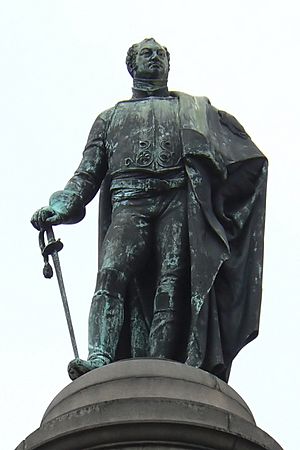
Many places were named after Prince Frederick:
- Fredericton, the capital of New Brunswick in Canada, was originally called "Frederick's Town."
- Duke of York Bay in Canada was named on his birthday, 16 August.
- In Western Australia, York County and the towns of York and Albany were named after him. Albany was first called "Frederick Town."
- The tall Duke of York Column in London was built in 1834 to remember Prince Frederick.
- The 72nd Regiment of Foot was given the title Duke of Albany's Own Highlanders in 1823.
- Fort Frederick, Port Elizabeth, the first British fort in southern Africa, was built in 1799 and named after him.
See also
 In Spanish: Federico de York para niños
In Spanish: Federico de York para niños
- Beer money – a notable military allowance of the time
- List of famous duels



